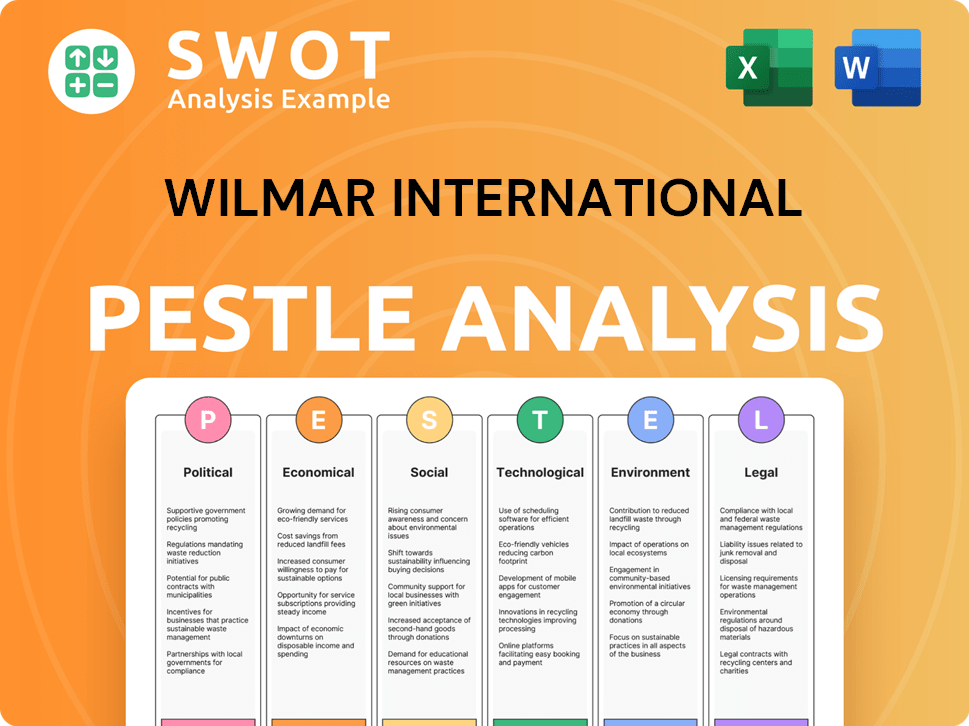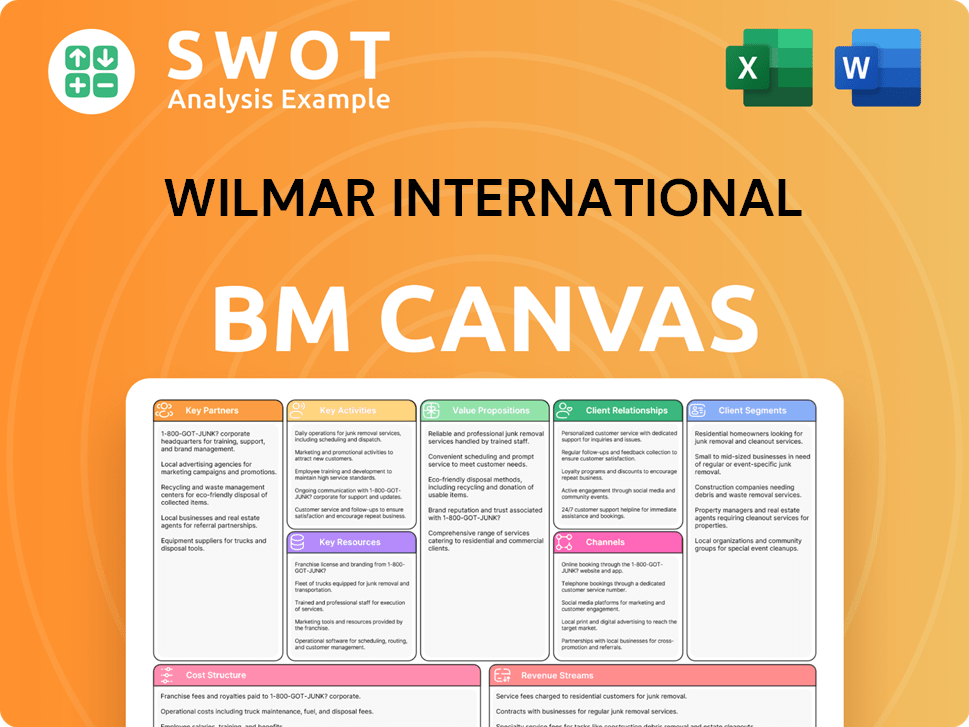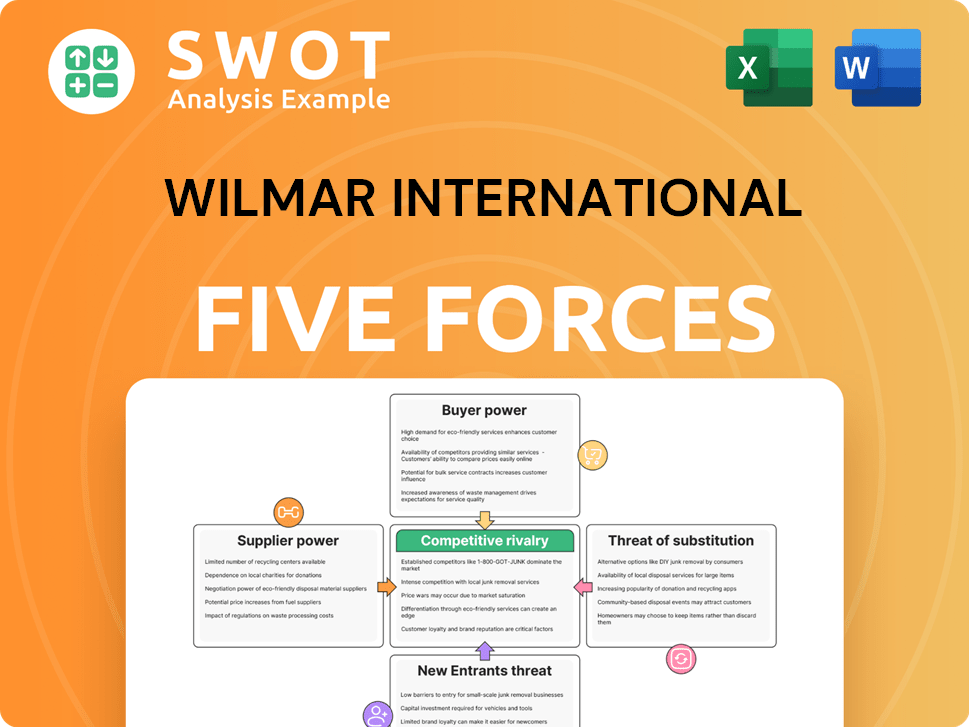Wilmar International Bundle
How Does Wilmar International Dominate the Global Agribusiness Market?
From humble beginnings as a palm oil trading company, Wilmar International has transformed into a global powerhouse, boasting an integrated agribusiness model that spans the entire value chain. This strategic evolution, marked by significant acquisitions and expansions, has positioned Wilmar at the forefront of the industry. Learn how this company has consistently adapted its Wilmar International SWOT Analysis to maintain its competitive edge.

This exploration will delve into the intricacies of Wilmar's sales strategy and marketing strategy, revealing how they've built a robust distribution network and cultivated strong brand recognition. We'll examine their innovative marketing tactics, brand positioning, and successful campaigns, providing a comprehensive Wilmar International sales and marketing overview. Understanding Wilmar's approach offers valuable insights into their Wilmar business model, Wilmar market analysis, and strategies for achieving Wilmar competitive advantage in a dynamic global market.
How Does Wilmar International Reach Its Customers?
The sales and marketing strategy of Wilmar International's growth strategy is built upon a robust, multifaceted approach to sales channels. This strategy combines both online and offline methods to ensure wide market reach across its extensive product range. Key sales channels include direct sales teams, wholesale distributors, and partner retailers.
The company's extensive distribution network is a cornerstone of its ability to reach about five billion consumers globally. This network includes over 1,000 manufacturing plants located across China, India, Indonesia, and approximately 50 other countries. This comprehensive approach allows for effective market penetration and ensures products are accessible to a vast consumer base.
The evolution of these channels reflects Wilmar's adaptive sales strategy. For consumer products like edible oils, rice, and noodles, Wilmar utilizes traditional retail outlets, supermarkets, and hypermarkets. Digital adoption is also significant, with the company enhancing its online ordering, logistics, and payment solutions.
Wilmar's sales strategy heavily relies on direct sales teams and wholesale distributors to reach both industrial and consumer markets. These teams are crucial for managing relationships and ensuring products are available where needed. This approach allows for efficient distribution and direct engagement with key customers.
Partnering with retailers is a key element of Wilmar's sales channel strategy. This includes supermarkets, convenience stores, and hypermarkets, which are essential for reaching consumers. This strategy ensures that Wilmar's products are readily available to a broad audience.
Wilmar has enhanced its online ordering, logistics, and payment solutions. This integration improves visibility throughout the sales cycle and optimizes costs. This digital approach supports efficiency and responsiveness to customer needs.
Strategic partnerships and acquisitions are instrumental in Wilmar's growth. The acquisition of a controlling stake in Adani Wilmar Limited in December 2024 is a prime example. This enhances Wilmar's presence in the FMCG market, including a strong distribution network.
Wilmar's expansion strategies include strengthening its distribution in India, expanding to over 121 million households in 2024 through its joint venture. New ventures like Wilmar Kitchen Concepts Pte. Ltd. and Wilmar Food Solutions Pte. Ltd., incorporated in Singapore in March 2024, show expansion into food catering and prepared food manufacturing. In April 2024, Wilmar Distribution Pte. Ltd. acquired a 50% interest in BWY Wilmar Pte. Ltd.
- Focus on India: Expanding distribution networks to reach a wider consumer base.
- Diversification: Entering new sectors like food catering and prepared food manufacturing.
- Strategic Acquisitions: Strengthening market presence through strategic investments.
- Digital Integration: Enhancing online platforms for better customer service and efficiency.
Wilmar International SWOT Analysis
- Complete SWOT Breakdown
- Fully Customizable
- Editable in Excel & Word
- Professional Formatting
- Investor-Ready Format

What Marketing Tactics Does Wilmar International Use?
The marketing tactics employed by Wilmar International are multifaceted, encompassing both digital and traditional strategies to enhance brand visibility and drive sales. The company leverages digital channels, including online advertising, search engine optimization (SEO), and social media campaigns, to engage with its target audiences. These efforts are complemented by traditional media approaches, ensuring a broad reach for its diverse product offerings.
Wilmar's approach is data-driven, utilizing market research and analytics to understand consumer preferences and market dynamics. This understanding informs targeted marketing initiatives and allows for the adaptation of products and messaging to suit local cultural preferences. The company is also focused on deepening its digitalization efforts across all business functions, including sales and marketing, to enable new business models and capabilities.
The company's sales teams are equipped with technology tools and data to conduct sales more effectively, including creating new apps to engage end-consumers and support community group buy initiatives in regions like China, Vietnam, and rural India. This integrated approach supports Wilmar's overall sales strategy and helps maintain its competitive advantage in the market.
Wilmar utilizes a robust digital marketing strategy to enhance brand visibility and engage with consumers. This includes online advertising, SEO, and social media campaigns across platforms like Facebook, Instagram, and LinkedIn.
Traditional media plays a crucial role, particularly for mass-market offerings. This approach ensures a broad reach, complementing the digital strategies to maximize market penetration.
Wilmar employs data-driven marketing by using market research to identify consumer preferences and trends. Analytics tools are used to understand market dynamics and inform targeted marketing initiatives.
The company focuses on localization, adapting products and messaging to fit cultural preferences in diverse consumer bases. This approach enhances brand recognition and fosters trust and loyalty.
Wilmar emphasizes customer segmentation and personalization to tailor its marketing efforts. This involves understanding consumer motivations and behaviors to create more effective campaigns.
Wilmar continues to invest in research and development to improve product quality, reduce costs, and develop healthier products, including plant-based proteins. This aligns with evolving consumer preferences.
Wilmar's approach to marketing strategy is comprehensive, integrating digital and traditional methods to reach a wide audience. The company's focus on data, localization, and customer segmentation allows it to tailor its efforts effectively. For example, in 2024, the company's subsidiary, Adani Wilmar, reported a revenue of approximately $6.4 billion USD, demonstrating the effectiveness of its dual marketing approach. To learn more about the company's overall strategies, you can read a detailed analysis of Wilmar International's business model.
Wilmar's marketing tactics are designed to build brand awareness, generate leads, and drive sales. These tactics are applied across various product lines and geographic regions.
- Digital Marketing: Online advertising, SEO, and social media campaigns.
- Traditional Media: Use of traditional media for mass-market offerings.
- Data-Driven Marketing: Market research, analytics, and targeted initiatives.
- Localization: Adapting products and messaging to local cultural preferences.
- Customer Segmentation: Tailoring marketing efforts based on consumer behavior.
- Product Innovation: Investing in R&D for product quality and health-focused products.
Wilmar International PESTLE Analysis
- Covers All 6 PESTLE Categories
- No Research Needed – Save Hours of Work
- Built by Experts, Trusted by Consultants
- Instant Download, Ready to Use
- 100% Editable, Fully Customizable

How Is Wilmar International Positioned in the Market?
The brand positioning of Wilmar International centers on its commitment to providing sustainable and high-quality agricultural products. This involves an integrated value chain, operational excellence, and a strong emphasis on sustainable practices. The company aims to improve the nutritional and environmental well-being of consumers worldwide, reflecting its extensive involvement in producing and marketing agricultural commodities.
Wilmar's core message is about reliability, natural goodness, and a global presence. The company's visual identity and tone of voice likely reflect these values, aligning with its diverse product offerings. Its marketing and sales strategy emphasizes value, quality, and sustainability, appealing to a broad consumer base.
Wilmar's brand identity is consistent across its expansive network of over 1,000 manufacturing plants and distribution channels, spanning approximately 50 countries. The company adapts its products and messaging to suit cultural preferences, demonstrating a commitment to localization. For more information on the company's ownership, consider reading about the Owners & Shareholders of Wilmar International.
Wilmar's 'No Deforestation, No Peat, No Exploitation' (NDPE) Policy, introduced in 2013, is a key aspect of its brand positioning related to environmental responsibility. This policy drives transformation across the palm oil and sugar sectors. The company's efforts in sustainability have been recognized, earning its fourth consecutive inclusion in the Dow Jones Sustainability Indices (DJSI) World Index in 2024.
In 2024, Wilmar achieved a score of 69 in the S&P Global Corporate Sustainability Assessment, placing it in the 95th percentile of all Food Products companies reviewed. This highlights its leadership in Environmental, Social, and Governance (ESG) pillars. This data underscores the company's commitment to sustainable practices.
Wilmar, through subsidiaries like Yihai Kerry Arawana (YKA) and Goodman Fielder, provides qualitative evidence of improving the nutritional quality of its products. There is an ongoing opportunity to further disclose information on salt, sugar, and fat reduction. This focus on nutrition is a key element of its marketing strategy.
Wilmar's consumer brands are known for their quality, with many having received awards in their respective markets. This recognition helps build brand loyalty and reinforces its market position. These awards are a testament to the quality of its products.
Wilmar adapts its products and messaging to fit cultural preferences, as seen in its localization efforts. This approach helps to resonate with diverse consumer bases. Adapting to local market needs is a crucial part of its sales strategy.
Wilmar International Business Model Canvas
- Complete 9-Block Business Model Canvas
- Effortlessly Communicate Your Business Strategy
- Investor-Ready BMC Format
- 100% Editable and Customizable
- Clear and Structured Layout

What Are Wilmar International’s Most Notable Campaigns?
Wilmar International's approach to sales and marketing is multifaceted, leveraging its integrated agribusiness model to create a strong market presence. While specific, named marketing campaigns are not always publicly detailed, the company's strategic initiatives serve as key drivers for growth. These initiatives often focus on expanding distribution networks, enhancing sustainability efforts, and investing in research and development.
The company's strategies are geared towards long-term growth and market relevance, particularly in the consumer products segment. The focus is on expanding market share, improving product quality, and meeting evolving consumer demands. These efforts are critical for maintaining a competitive edge in the global food and agribusiness industry.
Key campaigns for Wilmar International include expanding its distribution network, focusing on sustainability, and investing in research and development (R&D). These initiatives are essential for driving growth and reinforcing its market presence. These campaigns are not isolated efforts but are integrated into Wilmar's overall business strategy.
A significant 'campaign' involves expanding consumer product distribution, especially in emerging markets. In 2024, Adani Wilmar Limited (AWL), a joint venture, expanded its reach in India's FMCG market. This expansion included distributing oils, rice, flour, and other essentials to over 121 million households. This strategic move aims to increase market share and household penetration.
Wilmar's commitment to sustainability is a continuous, company-wide initiative. Objectives include achieving 100% traceability to the mill level by 2024 and to oil palm plantations by 2025. The 2024 Sustainability Report, themed 'Together We Thrive,' details the progress. The company achieved SBTi validation for net-zero targets in March 2025.
Investment in R&D is an ongoing internal campaign to improve product quality and develop healthier options. These efforts contribute to the long-term growth and market relevance of the product portfolio. While direct sales figures are not publicly detailed, R&D supports the company's competitive edge.
Wilmar's sales strategy includes expanding in emerging markets. AWL's distribution network in India includes over 10,000 distributors and 0.72 million retail outlets. The acquisition of a controlling stake in AWL is expected to significantly enhance profitability from 2026. This demonstrates a focused approach to Wilmar International's competitors.
Wilmar International Porter's Five Forces Analysis
- Covers All 5 Competitive Forces in Detail
- Structured for Consultants, Students, and Founders
- 100% Editable in Microsoft Word & Excel
- Instant Digital Download – Use Immediately
- Compatible with Mac & PC – Fully Unlocked

Related Blogs
- What are Mission Vision & Core Values of Wilmar International Company?
- What is Competitive Landscape of Wilmar International Company?
- What is Growth Strategy and Future Prospects of Wilmar International Company?
- How Does Wilmar International Company Work?
- What is Brief History of Wilmar International Company?
- Who Owns Wilmar International Company?
- What is Customer Demographics and Target Market of Wilmar International Company?
Disclaimer
All information, articles, and product details provided on this website are for general informational and educational purposes only. We do not claim any ownership over, nor do we intend to infringe upon, any trademarks, copyrights, logos, brand names, or other intellectual property mentioned or depicted on this site. Such intellectual property remains the property of its respective owners, and any references here are made solely for identification or informational purposes, without implying any affiliation, endorsement, or partnership.
We make no representations or warranties, express or implied, regarding the accuracy, completeness, or suitability of any content or products presented. Nothing on this website should be construed as legal, tax, investment, financial, medical, or other professional advice. In addition, no part of this site—including articles or product references—constitutes a solicitation, recommendation, endorsement, advertisement, or offer to buy or sell any securities, franchises, or other financial instruments, particularly in jurisdictions where such activity would be unlawful.
All content is of a general nature and may not address the specific circumstances of any individual or entity. It is not a substitute for professional advice or services. Any actions you take based on the information provided here are strictly at your own risk. You accept full responsibility for any decisions or outcomes arising from your use of this website and agree to release us from any liability in connection with your use of, or reliance upon, the content or products found herein.